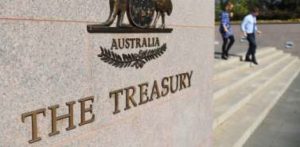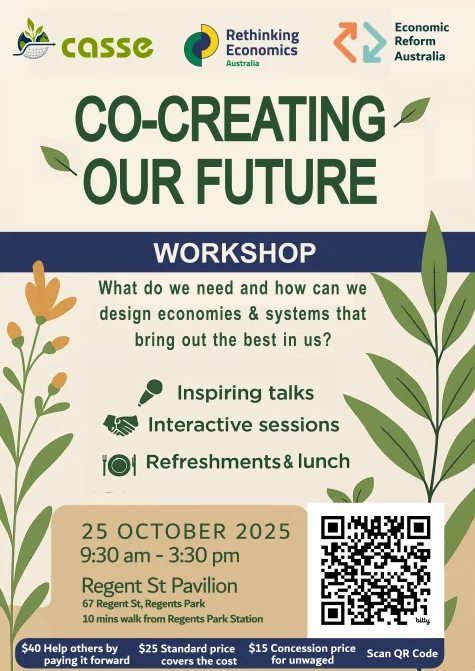Federal Treasury finances: a functional perspective
John Hermann
 We know that modern monetary theory offers an analysis of the flow of money within our economy, and in undertaking this task it utilises some basic insights, including its recognition that bank credit money and banking reserves are (a) destroyed when federal taxes are paid and when Federal Treasury securities are issued to the non-government sector, and (b) created when the Federal Government spends into the non-government sector. This article examines what the analysis implies within an Australian context, although the ideas and conclusions are more generally applicable. However we must firstly define what is meant by money.
We know that modern monetary theory offers an analysis of the flow of money within our economy, and in undertaking this task it utilises some basic insights, including its recognition that bank credit money and banking reserves are (a) destroyed when federal taxes are paid and when Federal Treasury securities are issued to the non-government sector, and (b) created when the Federal Government spends into the non-government sector. This article examines what the analysis implies within an Australian context, although the ideas and conclusions are more generally applicable. However we must firstly define what is meant by money.
-
What is money?
Most economic textbooks tell us that money is any entity which (a) is accepted and used by the public as a means of payment for taxes and debts and for purchasing goods and services — in other words it behaves as a medium of exchange; (b) can be used as a store of value; and (c) possesses a unit of account (which in Australia is called the Aus Dollar). Item (a) also implies that the range of monetary transactions occurring and permitted within the real economy embraces an adequately sized marketplace of players.
There exist three widely recognised forms of money:
-
Currency, by which we mean coins and banknotes.
-
Bank credit money, an intangible form of money created by commercial banks in the accounts of their retail depositors.
-
Banking reserves (or exchange settlement funds), an intangible form of money created in the depository accounts of commercial banks with the Central Bank (CB).
Items (a) and (c) are collectively some- times described as the monetary base.
In addition, we have the money supply – meaning money accessible and used by the nonbank sector – which can be defined in various ways, the simplest definition (“narrow” money) being the conjunction of bank credit money and currency in the hands of the nonbank sector.
Risk-free financial assets like Treasury securities are sometimes described as “near-money”, especially assets which are short-term and highly liquid. These financial assets are not generally used as a medium of exchange for buying and selling goods and services, but they could be so used if the need arose. They can be thought of as contributing to the stock of “broad” state fiat money.
We have excluded various alternative currencies like LETS and BITCOIN from the above list on the grounds that no government accepts their accounting units as a basis for paying taxes (at this stage), and therefore these entities tend to be regarded by central governments as investment assets.
-
-
Is Federal Treasury a bank?
Some economic commentators have suggested that the Federal Treasury behaves like a bank, but this view is negated by the following facts:
- Treasury does not take deposits from the public, or from the commercial banks.
- Federal Treasury does not directly create credit money in the accounts of non-banks (i.e. by contrast with the commercial banks). When the Treasury spends, it instructs the Central Bank to transfer reserves to the payee’s bank, which authorises that bank to create new credit money in the payee’s account.
- Unlike commercial banks, Treasury’s primary role is not as a store for private savings, or the creation of financial assets via retail lending for commercial profit.
- Treasury does not lend reserves to commercial banks (in contrast with the latter, which often lend reserves to each other).
-
What is the nature of Federal Treasury’s CB account?
Given that the Federal Treasury is not a bank, any positive entries in its account with the Central Bank should not be thought of as banking reserves (i.e. unlike those of commercial banks). And clearly these entries do not consist of bank credit money, which can only exist within the depository accounts that commercial banks make available to citizens and businesses. Neither are they currency, because they do not have a tangible form. So the question arises, are these Treasury credits a form of money in any sense at all?
Officially, they are not a form of money in the sense that they are excluded from the monetary base and from every measure of the money supply.
The following propositions and insights help to answer this question:
- A monetarily sovereign entity, i.e. one which has the power to create and destroy money, does not need to acquire such money from others for its own use, and does not need to store it.
- If the Federal Government Treasury is not a bank, then its “deposits” in the Central Bank will have a different function and status to the deposits of commercial banks in the central bank.
- One of the essential requirements of any entity entitled to be called money is that it can be traded and borrowed/ loaned between a number of market- place players (i.e. a number greater than one) who have similar status and objectives in regard to those operat- ions. Bank deposits in the Central Bank satisfy this criterion, since all of the players are in competition with each other with the common objective of maximising their financial profit. In contrast, the Federal Government maintains an account with its Central Bank for a quite different purpose, and its spending has a different objective.
- Bond sales by the Australian FederalTreasury do match net spending (deficit spending) these days, and so appear to top up the notional Treasury balance at Australia’s Central Bank – the Reserve Bank of Australia (RBA). However this is a relatively new development, having been voluntarily introduced in Australia under the guise of ‘sound financial policy’ in 1982, and is not the practice in some comparable economies, such as Canada.Thus the Australian Treasury has not, since 1982, borrowed directly from the RBA – by selling bonds directly to the RBA (sometimes described as Overt Monetary Financing) or by using any other accounting mechanism. Prior to 1982, it did sell bonds directly to the RBA, which meant – to take the logic to its obvious limit – that any number which appeared within the federal government account at the RBA was rendered functionally meaningless. This means that the credits appearing were not matchable to the conjunction of private sector taxing and external borrowing.The post-1982 voluntary constraint on the government-RBA relationship does not in any sense undermine Australia’s monetary sovereignty, but it does appear to do so – by obscuring the fact that the Australian Government cannot become insolvent in its own currency, and is not limited by its ability to attract ‘money’ into its account at the RBA.
- The situation in the U.S. is somewhat different, in that the constraint on direct borrowing by the Federal Treasury is not voluntary, but is enforced by legislation. However even in this case the constraint may be easily bypassed if there happens to be a need to do so.Within Australia and the U.S. there exist statutory regulations to the effect that, whenever a difference over policy exists between Treasury and CB which cannot be resolved by negotiation, the will of Federal Treasury will ultimately prevail. So even if a legislative constraint happens to exist on direct borrowing, the Treasury could – if it so wished – issue a quantity of new bonds to the private sector and at the same time arrange for the CB to buy the same quantity of bonds from the private sector. The net result is the equivalent of direct borrowing from the RBA.
- The economic mainstream hold that the Federal Government’s positive balance in its Central Bank account is a form of state fiat money, moreover one which is interchangeable with reserves. However the above propositions imply that such “deposits” are not money in any real sense, but are merely accumulated credits in an operating account. An operating account records a financial reality, but this does not imply that it is a form of money.
On this basis it may be said that the central government stands alone – that is, that it is not in competition with any other entities possessing accounts with the central bank, and that the entries in the Government’s RBA account do not actually function as a form of money in an operational sense.
Many of us like to think of financial economics as a science, but complex events like the financial crisis suggest that this conceit may be more wishful thinking than reality.
— Andrew Lo
Economists treat economics as if it is a pure science divorced from the facts of life. The result of this false accountancy is a wilful confusion under cover of which industry wreaks its havoc scot-free and ignores the environmental cost.
— Vivienne Westwood
In economics, the majority is always wrong.
— John Kenneth Galbraith





























